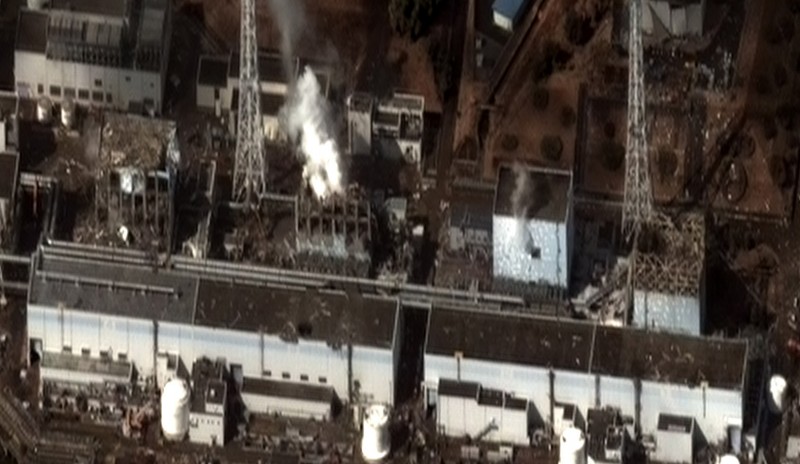
Fukushima Daiichi nuclear power complex in March 2011. Unit 1 reactor is on far right. Image from Wikipedia/Wikicommons [1].
Large Japanese electricity utility Tokyo Electric Power (Tepco) confirmed on Thursday, March 19 that nearly all fuel in one of four damaged nuclear reactors at Fukushima No. 1 nuclear power plant has melted and fallen into the containment building [2].
With the design of the Fukushima Daiichi plants, the containment building was a very simple shell protecting the reactor from the elements, but provided no real protection in the event of a nuclear accident. Instead, the nuclear reactor was enclosed in primary and secondary containment vessels, which sat atop a thick concrete pad at the base of the containment building.
In the event of a meltdown, the thick concrete pad is the only barrier between highly radioactive molten fuel and groundwater.
While there has been suspicions that nuclear fuel did melt its way through the containment vessel and to the base of the containment building, until Thursday there was no definitive proof meltdown had occurred.
The implication of the findings is that it will be very difficult to remove the highly radioactive molten fuel from Unit 1. As well, the molten fuel must continue to be cooled with water until it is removed.
Holes and fractures in the concrete base of the reactor building also means that groundwater continues to seep in and become irradiated before draining into the Pacific Ocean, causing an ongoing nuclear disaster.
Tepco's Fukushima Daiichi nuclear power facility was severely damaged [3] following the massive earthquake and subsequent tsunami that occurred on March 11, 2011.
.PNG/1024px-Fukushima_I_Nuclear_Powerplant_site_close-up_(wotext).PNG)
Location of six reactors at Fukushima Daiichi nuclear complex. Image courtesy Wikipedia.
Following the earthquake and tsunami, the Fukushima Daiichi nuclear power complex lost power and the ability to cool fuel in the reactors. [4] The lack of cooling caused a series of hydrogen explosions that severely damaged four of the six reactors at the Daiichi complex.
The resulting release of radioactivity and fears of even an even bigger disaster prompted the evacuation of towns located within a 30-km radius of the plant.
Meanwhile, the lack of power meant water could not be pumped in to cool the nuclear fuel in the reactors. The fuel rods in the reactor vessel started to melt, eventually pooling on the bottom of the reactor vessel.
Eventually the molten fuel melted through the primary and secondary containment vessels, and pooled on the concrete pad at the base of the reactor.
Ever since March 11, 2011, there have been questions about the state of the nuclear fuel in the containment vessels of the four damaged reactor buildings. The interiors of the reactor buildings remain highly radioactive and lethal for human beings to enter.
The amount of debris and destruction within the reactor buildings plus flooding has made entry by robots and remotely-operated vehicles challenging.
専門家が指摘する〝メルトアウト〟の可能性 pic.twitter.com/0Izh7vn1H9 [5]
— ひろみ (@hiromi19610226) March 19, 2015 [6]
How meltdown occurred according to experts. [Image shows presumed current location of molten fuel in the basement of Unit 1 containment building, separated from water table by the concrete bad supporting the reactor building.]
The location of the molten fuel was achieved using a technique called muon scattering tomography [7]. Muons are elementary particles associated with cosmic radiation reaching the Earth from outer space.
While muons penetrate most matter, the particles change direction when encountering certain elements, in this case the uranium in nuclear fuel. Researchers used this characteristic to check for the presence of fuel in the Unit 1 reactor.
However, the behavior of the muon particles indicated that no fuel remains in the reactor itself.
NHKの映像② 福島第一原発にて先月から行われていた溶け落ちた核燃料を探す調査で 1号機の原子炉の中に 核燃料が見当たらない ことがわかりました 映像 http://t.co/XTyDgeMGUg [8] pic.twitter.com/SEk8VCUjiR [9] — * peace * (@cyoki) March 19, 2015 [10]
NHK image: A study was conducted in February 2012 searching for the melted remains of nuclear fuel in Unit 1.
>>The study showed that no fuel remains could be found in the reactor (indicating the fuel had melted through the bottom of the reactor into the basement of the reactor).<<
[Captions, from top left: Muon scattering tomography used to analyze interior of Unit 1 reactor; No fuel can be detected within interior of the reactor; (Simulation) Very little nuclear fuel remains in reactor or containment vessel; Nuclear reactor and containment vessel; white areas indicate absence of any fuel.]
As has been predicted, most of the molten fuel has settled on the concrete pad that supporting the containment vessels in the base of the containment building.
福島第一原発1号機、炉内燃料ほぼ全量が溶融 http://t.co/e5KioYvfRx [11] pic.twitter.com/fSLimpr8ho [12] — Koji (@kwave526) March 19, 2015 [13]
Almost none of the molten fuel in the Unit 1 remains in the reactor. [Image caption: Molten fuel melts through the pressure vessel onto the floor of the containment building.]